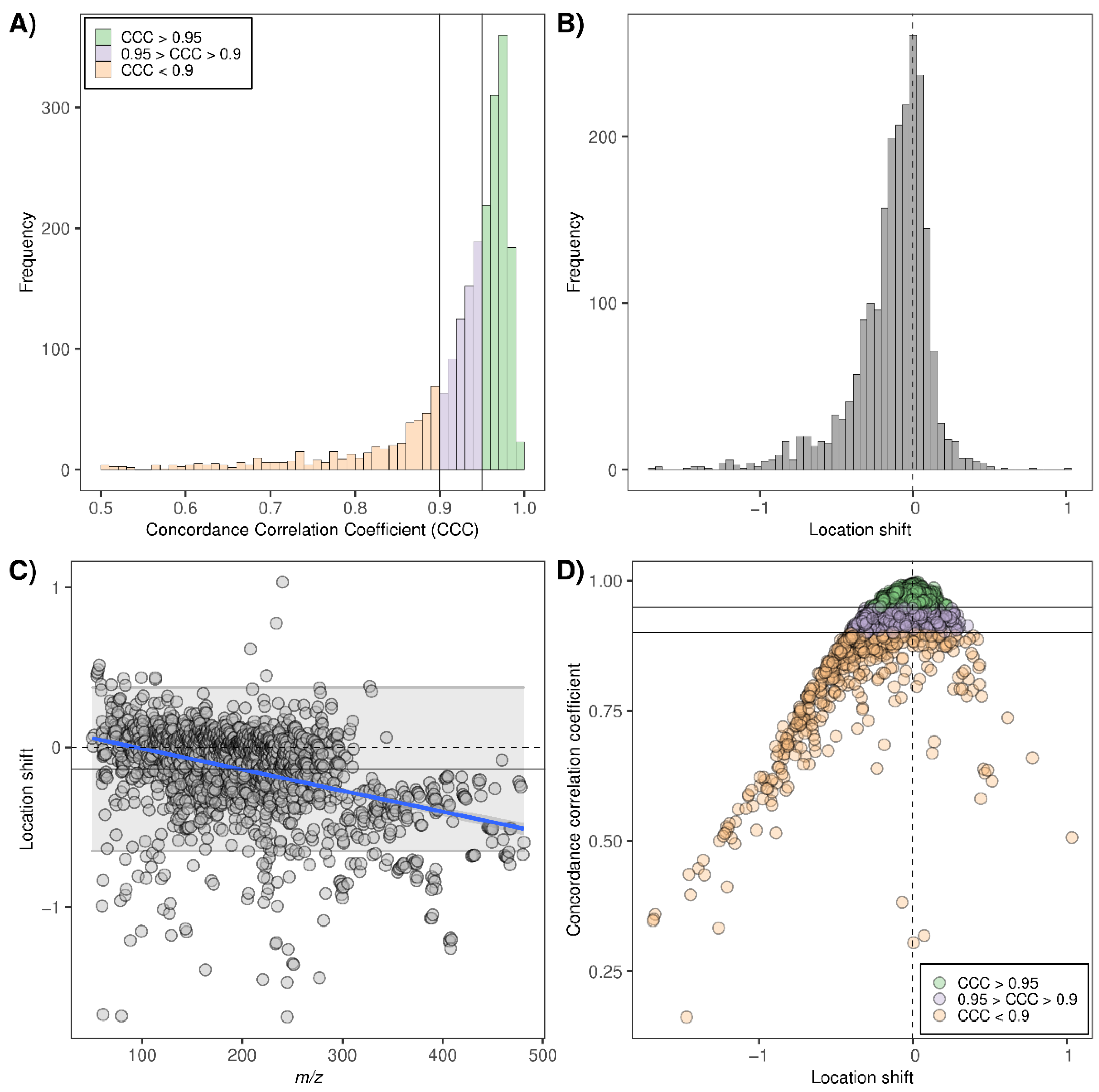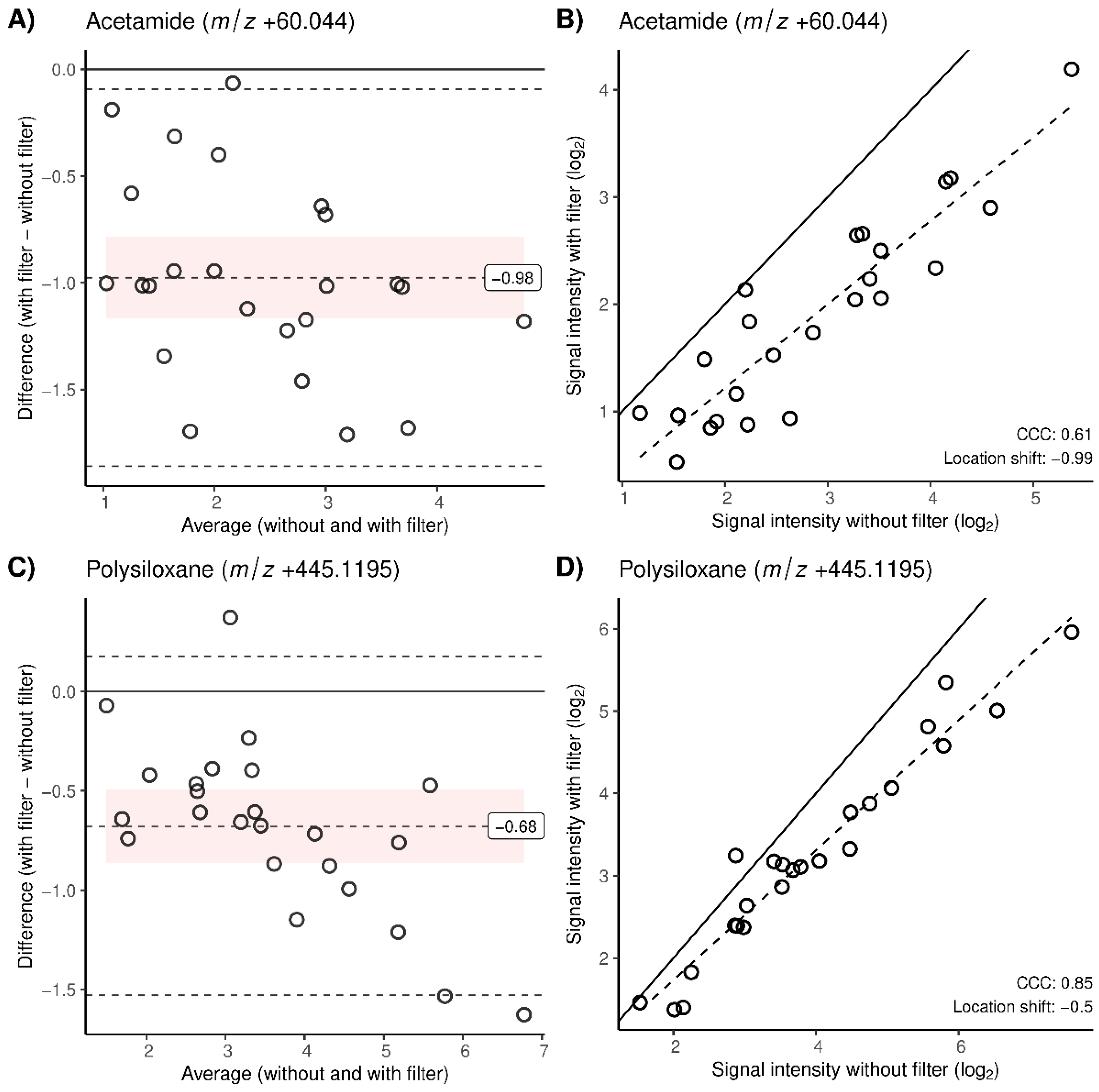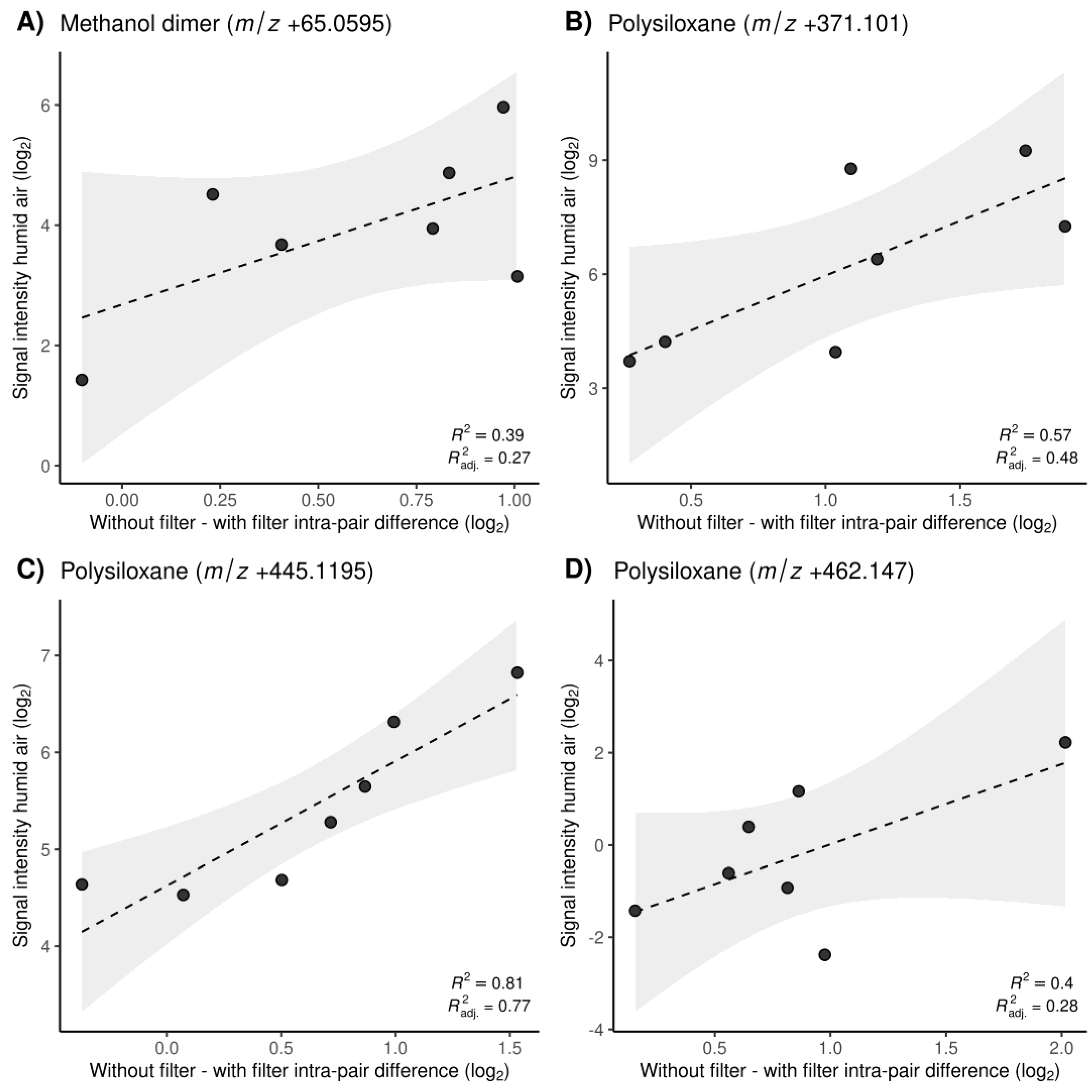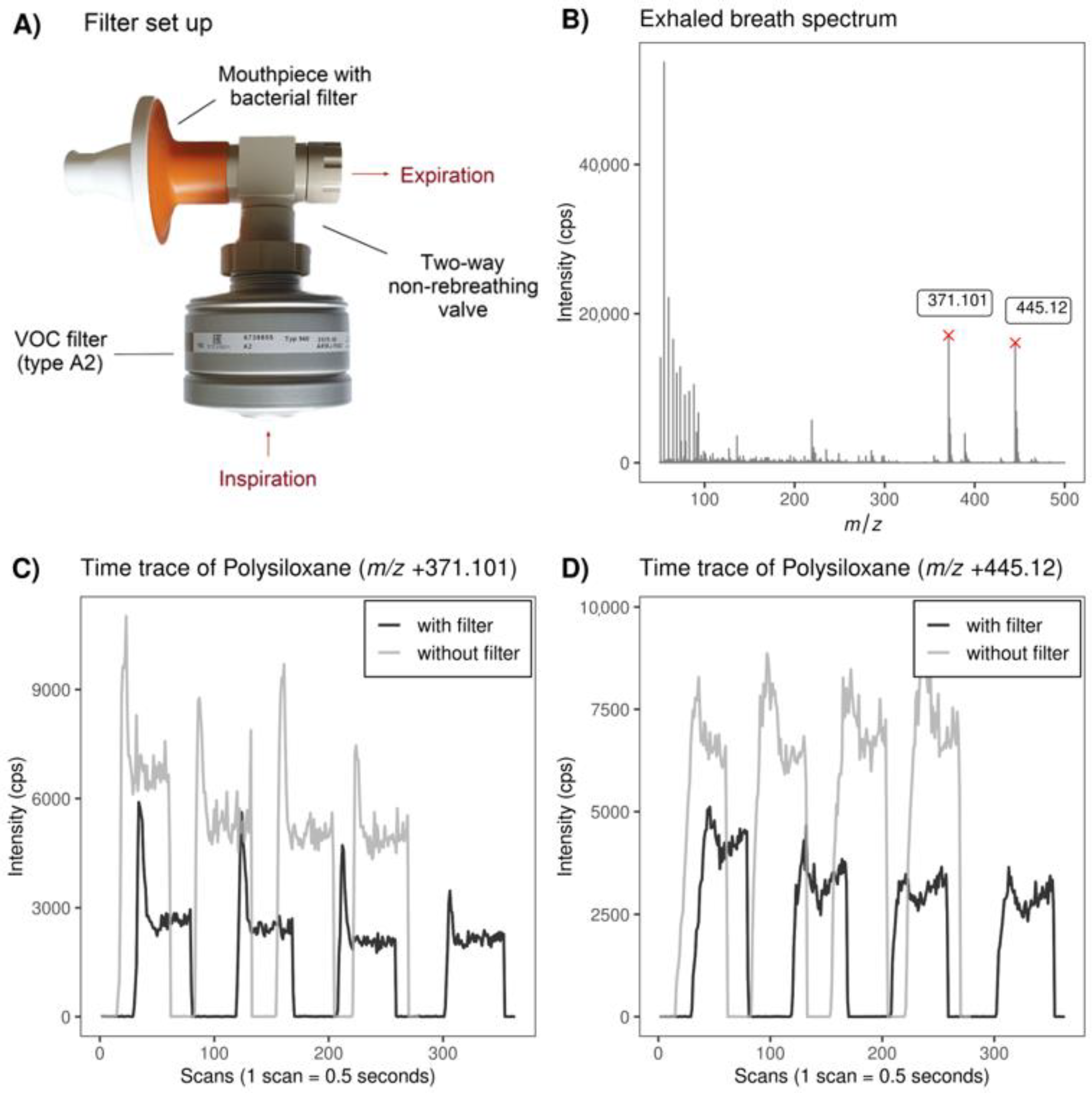Effects of a Volatile Organic Compound Filter on Breath Profiles Measured by Secondary Electrospray High-Resolution Mass Spectrometry
Abstract
1. Introduction
2. Results
2.1. Assessment of Exhaled Metabolites after Filter Usage
2.2. Effect of the Filter on Contaminants
2.3. Effects on VOCs in Ambient Air
3. Discussion
3.1. Impact of Filter Usage on Breath Profiles
3.2. Behavior of Contaminants after Filter Application
3.3. Comparison to Previous Studies
3.4. Applicability of a VOC Filter in Pediatric Studies
4. Materials and Methods
4.1. Study Design and Participants
4.2. Breath Analysis Measurements
4.3. Ambient Air Samples
4.4. Data Processing and Data Analysis
5. Conclusions
Supplementary Materials
Author Contributions
Funding
Institutional Review Board Statement
Informed Consent Statement
Data Availability Statement
Acknowledgments
Conflicts of Interest
Sample Availability
References
- Popov, T.A. Human exhaled breath analysis. Ann. Allergy Asthma Immunol. 2011, 106, 451–456. [Google Scholar] [CrossRef] [PubMed]
- Dhondt, H.; Goelen, E.; Koppen, G.; Verschaeve, L. Relation between ambient air and breath volatile organic compounds. Wit Trans. Biomed. Health 2007, 11, 33–40. [Google Scholar] [CrossRef][Green Version]
- Bruderer, T.; Gaugg, M.T.; Cappellin, L.; Lopez-Hilfiker, F.; Hutterli, M.A.; Perkins, N.; Zenobi, R.; Moeller, A. Detection of Volatile Organic Compounds with Secondary Electrospray Ionization and Proton Transfer Reaction High-Resolution Mass Spectrometry: A Feature Comparison. J. Am. Soc. Mass Spectrom. 2020, 31, 1632–1640. [Google Scholar] [CrossRef] [PubMed]
- Basanta, M.; Ibrahim, B.; Douce, D.; Morris, M.; Woodcock, A.; Fowler, S.J. Methodology Validation, Intra-Subject Reproducibility and Stability of Exhaled Volatile Organic Compounds. J. Breath. Res. 2012, 6, 026002. [Google Scholar] [CrossRef]
- Dragonieri, S.; Quaranta, V.; Carratù, P.; Ranieri, T.; Buonamico, E.; Carpagnano, G. Breathing Rhythm Variations during Wash-In Do Not Influence Exhaled Volatile Organic Compound Profile Analyzed by an Electronic Nose. Molecules 2021, 26, 2695. [Google Scholar] [CrossRef]
- Kos, R.; Brinkman, P.; Neerincx, A.H.; Paff, T.; Gerritsen, M.G.; Lammers, A.; Kraneveld, A.D.; Heijerman, H.G.; Janssens, H.M.; Davies, J.C.; et al. Targeted exhaled breath analysis for detection of Pseudomonas aeruginosa in cystic fibrosis patients. J. Cyst. Fibros. 2021, 21, e28–e34. [Google Scholar] [CrossRef]
- Fens, N.; Zwinderman, A.H.; van der Schee, M.P.; de Nijs, S.B.; Dijkers, E.; Roldaan, A.C.; Cheung, D.; Bel, E.H.; Sterk, P.J. Exhaled Breath Profiling Enables Discrimination of Chronic Obstructive Pulmonary Disease and Asthma. Am. J. Respir. Crit. Care Med. 2009, 180, 1076–1082. [Google Scholar] [CrossRef]
- Dragonieri, S.; Schot, R.; Mertens, B.J.; Le Cessie, S.; Gauw, S.A.; Spanevello, A.; Resta, O.; Willard, N.P.; Vink, T.J.; Rabe, K.F.; et al. An electronic nose in the discrimination of patients with asthma and controls. J. Allergy Clin. Immunol. 2007, 120, 856–862. [Google Scholar] [CrossRef]
- Bhavra, K.K.; Wilde, M.; Richardson, M.; Cordell, R.; Thomas, P.; Zhao, B.; Bryant, L.; Brightling, C.E.; Ibrahim, W.; Salman, D.; et al. The utility of a standardised breath sampler in school age children within a real-world prospective study. J. Breath. Res. 2022, 16, 027104. [Google Scholar] [CrossRef]
- Maurer, F.; Wolf, A.; Fink, T.; Rittershofer, B.; Heim, N.; Volk, T.; Baumbach, J.I.; Kreuer, S. Wash-out of Ambient Air Contaminations for Breath Measurements. J. Breath Res. 2014, 8, 027107. [Google Scholar] [CrossRef]
- Di Gilio, A.; Palmisani, J.; Ventrella, G.; Facchini, L.; Catino, A.; Varesano, N.; Pizzutilo, P.; Galetta, D.; Borelli, M.; Barbieri, P.; et al. Breath Analysis: Comparison among Methodological Approaches for Breath Sampling. Molecules 2020, 25, 5823. [Google Scholar] [CrossRef] [PubMed]
- Risby, T.H.; Sehnert, S.S. Clinical application of breath biomarkers of oxidative stress status. Free Radic. Biol. Med. 1999, 27, 1182–1192. [Google Scholar] [CrossRef] [PubMed]
- Weber, R.; Haas, N.; Baghdasaryan, A.; Bruderer, T.; Inci, D.; Micic, S.; Perkins, N.; Spinas, R.; Zenobi, R.; Moeller, A. Volatile organic compound breath signatures of children with cystic fibrosis by real-time SESI-HRMS. Erj Open Res. 2020, 6. [Google Scholar] [CrossRef] [PubMed]
- Gaugg, M.T.; Nussbaumer-Ochsner, Y.; Bregy, L.; Engler, A.; Stebler, N.; Gaisl, T.; Bruderer, T.; Nowak, N.; Sinues, P.; Zenobi, R.; et al. Real-Time Breath Analysis Reveals Specific Metabolic Signatures of COPD Exacerbations. Chest 2019, 156, 269–276. [Google Scholar] [CrossRef] [PubMed]
- Schwarz, E.I.; Martinez-Lozano Sinues, P.; Bregy, L.; Gaisl, T.; Gomez, D.G.; Gaugg, M.T.; Suter, Y.; Stebler, N.; Nussbaumer-Ochsner, Y.; E Bloch, K.; et al. Effects of CPAP therapy withdrawal on exhaled breath pattern in obstructive sleep apnoea. Thorax 2015, 71, 110–117. [Google Scholar] [CrossRef]
- Singh, K.D.; Tancev, G.; Decrue, F.; Usemann, J.; Appenzeller, R.; Barreiro, P.; Jaumà, G.; Santiago, M.M.; de Miguel, G.V.; Frey, U.; et al. Standardization procedures for real-time breath analysis by secondary electrospray ionization high-resolution mass spectrometry. Anal. Bioanal. Chem. 2019, 411, 4883–4898. [Google Scholar] [CrossRef]
- Mahon, G.M. A Proposal for Strength-of-Agreement Criteria for Lin’s Concordance Correlation Coefficient; National Institute of Water & Atmospheric Research Ltd.: Auckland, New Zealand, 2005. [Google Scholar]
- Li, L.; Sun, Z.; Li, H.; Keener, T.C. Effects of activated carbon surface properties on the adsorption of volatile organic compounds. J. Air Waste Manag. Assoc. 2012, 62, 1196–1202. [Google Scholar] [CrossRef]
- Furey, A.; Moriarty, M.; Bane, V.; Kinsella, B.; Lehane, M. Ion suppression; A critical review on causes, evaluation, prevention and applications. Talanta 2013, 115, 104–122. [Google Scholar] [CrossRef]
- King, R.; Bonfiglio, R.; Fernandez-Metzler, C.; Miller-Stein, C.; Olah, T. Mechanistic investigation of ionization suppression in electrospray ionization. J. Am. Soc. Mass Spectrom. 2000, 11, 942–950. [Google Scholar] [CrossRef]
- Law, W.S.; Wang, R.; Hu, B.; Berchtold, C.; Meier, L.; Chen, H.; Zenobi, R. On the Mechanism of Extractive Electrospray Ionization. Anal. Chem. 2010, 82, 4494–4500. [Google Scholar] [CrossRef]
- Spesyvyi, A.; Lacko, M.; Dryahina, K.; Smith, D.; Španěl, P. Ligand Switching Ion Chemistry: An SIFDT Case Study of the Primary and Secondary Reactions of Protonated Acetic Acid Hydrates with Acetone. J. Am. Soc. Mass Spectrom. 2021, 32, 2251–2260. [Google Scholar] [CrossRef]
- Phillips, M. Method for the Collection and Assay of Volatile Organic Compounds in Breath. Anal. Biochem. 1997, 247, 272–278. [Google Scholar] [CrossRef] [PubMed]
- Schubert, J.K.; Miekisch, W.; Birken, T.; Geiger, K.; Nöldge-Schomburg, G.F.E. Impact of inspired substance concentrations on the results of breath analysis in mechanically ventilated patients. Biomarkers 2005, 10, 138–152. [Google Scholar] [CrossRef] [PubMed]
- Miekisch, W.; Schubert, J.K.; Noeldge-Schomburg, G.F. Diagnostic potential of breath analysis—Focus on volatile organic compounds. Clin. Chim. Acta 2004, 347, 25–39. [Google Scholar] [CrossRef]
- Salman, D.; Ibrahim, W.; Kanabar, A.; Joyce, A.; Zhao, B.; Singapuri, A.; Wilde, M.; Cordell, R.L.; McNally, T.; Ruszkiewicz, D.; et al. The variability of volatile organic compounds in the indoor air of clinical environments. J. Breath Res. 2022, 16, 016005. [Google Scholar] [CrossRef]
- Hewitt, M.J.; Belluomo, I.; Zuffa, S.; Boshier, P.R.; Myridakis, A. Variation of Volatile Organic Compound Levels within Am-bient Room Air and Its Impact upon the Standardisation of Breath Sampling. Sci. Rep. 2022, 12, 15887. [Google Scholar] [CrossRef] [PubMed]
- Kaeslin, J.; Micic, S.; Weber, R.; Müller, S.; Perkins, N.; Berger, C.; Zenobi, R.; Bruderer, T.; Moeller, A. Differentiation of Cystic Fibrosis-Related Pathogens by Volatile Organic Compound Analysis with Secondary Electrospray Ionization Mass Spectrometry. Metabolites 2021, 11, 773. [Google Scholar] [CrossRef]
- Weber, R.; Streckenbach, B.; Welt, L.; Inci, D.; Kohler, M.; Perkins, N.; Zenobi, R.; Micic, S.; Moeller, A. Metabolic Signatures for Allergic Asthma in Children by Online Breath Analysis. Eur. Respir. J. 2022. submitted. [Google Scholar]
- Lawrence, I.; Lin, K. A Concordance Correlation Coefficient to Evaluate Reproducibility. Biometrics 1989, 45, 255. [Google Scholar] [CrossRef]
- Bland, J.M.; Altman, D.G. Statistical methods for assessing agreement between two methods of clinical measurement. Lancet 1986, 327, 307–310. [Google Scholar] [CrossRef]
- Gaugg, M.T.; Engler, A.; Nussbaumer-Ochsner, Y.; Bregy, L.; Stöberl, A.S.; Gaisl, T.; Bruderer, T.; Zenobi, R.; Kohler, M.; Martinez-Lozano Sinues, P. Metabolic Effects of Inhaled Salbutamol Determined by Exhaled Breath Analysis. J Breath Res 2017, 11, 046004. [Google Scholar] [CrossRef] [PubMed]
- García-Gómez, D.; Martínez-Lozano Sinues, P.; Barrios-Collado, C.; Vidal-de-Miguel, G.; Gaugg, M.; Zenobi, R. Identification of 2-Alkenals, 4-Hydroxy-2-Alkenals, and 4-Hydroxy-2,6-Alkadienals in Exhaled Breath Condensate by UHPLC-HRMS and in Breath by Real-Time HRMS. Anal Chem 2015, 87, 3087–3093. [Google Scholar] [CrossRef] [PubMed]
- Gaugg, M.T.; Bruderer, T.; Nowak, N.; Eiffert, L.; Martinez-Lozano Sinues, P.; Kohler, M.; Zenobi, R. Mass-Spectrometric Detection of Omega-Oxidation Products of Aliphatic Fatty Acids in Exhaled Breath. Anal Chem 2017, 89, 10329–10334. [Google Scholar] [CrossRef]
- García-Gómez, D.; Gaisl, T.; Bregy, L.; Cremonesi, A.; Sinues, P.M.-L.; Kohler, M.; Zenobi, R. Real-Time Quantification of Amino Acids in the Exhalome by Secondary Electrospray Ionization–Mass Spectrometry: A Proof-of-Principle Study. Clin Chem 2016, 62, 1230–1237. [Google Scholar] [CrossRef] [PubMed]
- Rioseras, A.T.; Singh, K.D.; Nowak, N.; Gaugg, M.T.; Bruderer, T.; Zenobi, R.; Sinues, P.M.-L. Real-Time Monitoring of Tricarboxylic Acid Metabolites in Exhaled Breath. Anal Chem 2018, 90, 6453–6460. [Google Scholar] [CrossRef] [PubMed]
- Martinez-Lozano Sinues, P.; Meier, L.; Berchtold, C.; Ivanov, M.; Sievi, N.; Camen, G.; Kohler, M.; Zenobi, R. Breath Analysis in Real Time by Mass Spectrometry in Chronic Obstructive Pulmonary Disease. Respiration 2014, 87, 301–310. [Google Scholar] [CrossRef] [PubMed]
- Nowak, N.; Gaisl, T.; Miladinovic, D.; Marcinkevics, R.; Osswald, M.; Bauer, S.; Buhmann, J.; Zenobi, R.; Sinues, P.; Brown, S.A.; et al. Rapid and Reversible Control of Human Metabolism by Individual Sleep States. Cell Rep 2021, 37, 109903. [Google Scholar] [CrossRef]
- Martínez-Lozano, P.; Zingaro, L.; Finiguerra, A.; Cristoni, S. Secondary Electrospray Ionization-Mass Spectrometry: Breath Study on a Control Group. J Breath Res 2011, 5, 016002. [Google Scholar] [CrossRef]
- García-Gómez, D.; Gaisl, T.; Bregy, L.; Martínez-Lozano Sinues, P.; Kohler, M.; Zenobi, R. Secondary Electrospray Ionization Coupled to High-Resolution Mass Spectrometry Reveals Tryptophan Pathway Metabolites in Exhaled Human Breath. Chem. Commun. 2016, 52, 8526–8528. [Google Scholar] [CrossRef]
- Keller, B.O.; Sui, J.; Young, A.B.; Whittal, R.M. Interferences and contaminants encountered in modern mass spectrometry. Anal. Chim. Acta 2008, 627, 71–81. [Google Scholar] [CrossRef]





| Mode | m/z | Compound | CCC | Location Shift | Bland–Altman Bias | Elevated In | In Ambient Air |
|---|---|---|---|---|---|---|---|
| neg | 129.0915 | Heptanoic acid | 0.51 | −1.18 | −0.79 | No filter | Yes |
| neg | 143.107 | Octanoic acid | 0.56 | −1.14 | −0.86 | No filter | Yes |
| pos | 127.111 | 2-Octenal | 0.57 | −1.04 | −0.87 | No filter | Yes |
| pos | 55.039 | Water trimer | 0.63 | 0.47 | 0.12 | Filter | Yes |
| pos | 253.2145 | 4-Hydroxy-2,6-hexadecadienal | 0.83 | −0.15 | −0.13 | No filter | Yes |
| pos | 143.106 | 4-Hydroxy-2-octenal | 0.83 | −0.51 | −0.23 | No filter | Yes |
| neg | 199.134 | ω-Oxoundecanoic acid | 0.85 | −0.51 | −0.52 | No filter | Yes |
| pos | 116.07 | Proline | 0.88 | −0.29 | −0.14 | No filter | No |
| neg | 157.087 | ω-Oxooctanoic acid | 0.89 | −0.47 | −0.41 | No filter | Yes |
| neg | 159.1025 | ω-Hydroxyoctanoic acid | 0.89 | −0.45 | −0.45 | No filter | No |
| pos | 76.039 | Glycine | 0.89 | 0.13 | 0.06 | Filter | No |
| Mode | m/z | Compound | CCC | Location Shift | Bland–Altman Bias | Elevated In | In Ambient Air |
|---|---|---|---|---|---|---|---|
| pos | 388.128 | Polysiloxane | 0.59 | −1.07 | −1.56 | No filter | Yes |
| pos | 60.044 | Acetamide | 0.61 | −0.99 | −0.98 | No filter | Yes |
| pos | 65.0595 | Methanol dimer | 0.67 | −0.63 | −0.67 | No filter | Yes |
| pos | 355.069 | Polysiloxane | 0.71 | −0.78 | −1.17 | No filter | Yes |
| pos | 371.101 | Polysiloxane | 0.73 | −0.73 | −1.20 | No filter | Yes |
| pos | 429.088 | Polysiloxane | 0.77 | −0.68 | −0.80 | No filter | Yes |
| pos | 462.147 | Polysiloxane | 0.78 | −0.68 | −1.00 | No filter | Yes |
| pos | 445.1195 | Polysiloxane | 0.85 | −0.50 | −0.68 | No filter | Yes |
| pos | 149.023 | Fragment of phthalate esters | 0.88 | 0.00 | −0.00 | - | No |
| pos | 74.0595 | Dimethyl formamide | 0.89 | −0.36 | −0.30 | No filter | Yes |
Disclaimer/Publisher’s Note: The statements, opinions and data contained in all publications are solely those of the individual author(s) and contributor(s) and not of MDPI and/or the editor(s). MDPI and/or the editor(s) disclaim responsibility for any injury to people or property resulting from any ideas, methods, instructions or products referred to in the content. |
© 2022 by the authors. Licensee MDPI, Basel, Switzerland. This article is an open access article distributed under the terms and conditions of the Creative Commons Attribution (CC BY) license (https://creativecommons.org/licenses/by/4.0/).
Share and Cite
Weber, R.; Kaeslin, J.; Moeller, S.; Perkins, N.; Micic, S.; Moeller, A. Effects of a Volatile Organic Compound Filter on Breath Profiles Measured by Secondary Electrospray High-Resolution Mass Spectrometry. Molecules 2023, 28, 45. https://doi.org/10.3390/molecules28010045
Weber R, Kaeslin J, Moeller S, Perkins N, Micic S, Moeller A. Effects of a Volatile Organic Compound Filter on Breath Profiles Measured by Secondary Electrospray High-Resolution Mass Spectrometry. Molecules. 2023; 28(1):45. https://doi.org/10.3390/molecules28010045
Chicago/Turabian StyleWeber, Ronja, Jérôme Kaeslin, Sophia Moeller, Nathan Perkins, Srdjan Micic, and Alexander Moeller. 2023. "Effects of a Volatile Organic Compound Filter on Breath Profiles Measured by Secondary Electrospray High-Resolution Mass Spectrometry" Molecules 28, no. 1: 45. https://doi.org/10.3390/molecules28010045
APA StyleWeber, R., Kaeslin, J., Moeller, S., Perkins, N., Micic, S., & Moeller, A. (2023). Effects of a Volatile Organic Compound Filter on Breath Profiles Measured by Secondary Electrospray High-Resolution Mass Spectrometry. Molecules, 28(1), 45. https://doi.org/10.3390/molecules28010045







